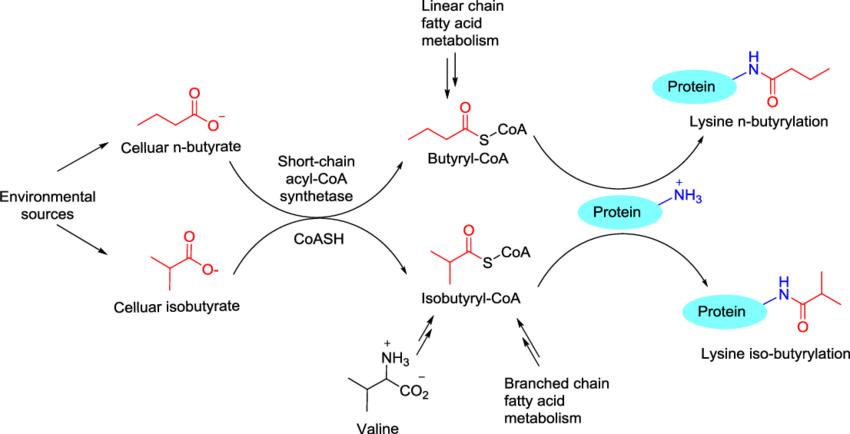Butyrylation Analysis Service
Butyrylation is a newly discovered type of conserved PTM that occurs primarily on lysine and is widespread in a wide range of proteins in both prokaryotes and eukaryotes. Creative Proteomics offers high-quality butyrylation analysis services, including identification, quantification and characterization of protein butyrylation modifications, providing valuable insights into your protein research.
What is Butyrylation
Lysine butyrylation is structurally similar to lysine acetylation and lysine propionylation, and it is also reversible and dynamic in its regulation. Histone butyrylation arises from the metabolism of butyric acid molecules, which have long been regarded as histone deacetylase inhibitors and used in the clinical treatment of a variety of tumors. It has been found that butyrylation and acetylation can be catalyzed by the same acyltransferase and share many of the same acylation sites and similar physiological activities.

Fig.1 Schematic of butyrylation (Zhu, Z. et al.; 2021)
Histone lysine butyrylation was found to increase the functional diversity of nucleosomes far beyond acetylation. For example, in spermatocyte differentiation, histone butyrylation competes with acetylation, particularly at H4K5, to prevent the binding of Brdt. Brdt mediates the stage-specific gene expression program and chromatin reorganization after meiosis, and butyrylation at H4K5 also marks a delay in the removal of histones during late spermatogenesis. In addition protein butyrylation affects amino acid and fatty acid metabolism, redox homeostasis, and regulation of the biological clock. Changes in butyrylation are sensitive to changes in the external and internal environment, especially energy metabolism.
Applications of Butyrylation Analysis
Reproductive Development
Butyrylation plays a unique biological function in sperm formation. An in-depth exploration of the physiological mechanisms of reproductive development.
Metabolic Regulation
Explore how butyrylation influences metabolic pathways and enzymes, particularly its role in energy metabolism and nutrient sensing.
Protein Function and Structure
Examine the effects of butyrylation on protein function and structure, providing insights into its modulatory role in diverse cellular activities.
Our Service
Creative Proteomics has advanced protein detection technologies and can provide customized services to researchers and scientists to help them reveal the complexity of PTM using powerful mass spectrometry technologies. Our services are thoughtful and detailed and the process of butyrylation analysis service is as follows:

Fig.2 Butyrylation analysis workflow
- Sample Preparation
Proper extraction and preparation of proteins from biological samples to ensure preservation of butyrylated proteins. - Butyrylation Enrichment
Enrichment techniques are employed to isolate malonylate proteins or peptides. This step is crucial as butyrylation modifications are often present in low abundance compared to unmodified proteins. - Detection
WB, protein microarrays and LC-MS/MS are powerful tools for the identification and quantification of malonylate peptides, and they provide detection information that facilitates a comprehensive analysis of butyrylation. - Bioinformatics Analysis
Advanced bioinformatics tools are used to analyze data, identify malonylate peptides, and map these modifications to protein sequences. - Result Delivery
After professional data analysis, we deliver results quickly and consistently.
Creative Proteomics brings a wealth of experience to the field of protein research. Our comprehensive services and products cover the entire spectrum of utilizing suitable and efficient gateways. Utilizing our proprietary platform, we have successfully implemented many proteomics research projects. If you are interested, please contact us for more information and a quote.
Reference
- Zhu, Z.; et al. Identification of lysine isobutyrylation as a new histone modification mark. Nucleic Acids Research. 2021, 49(1): 177-189

